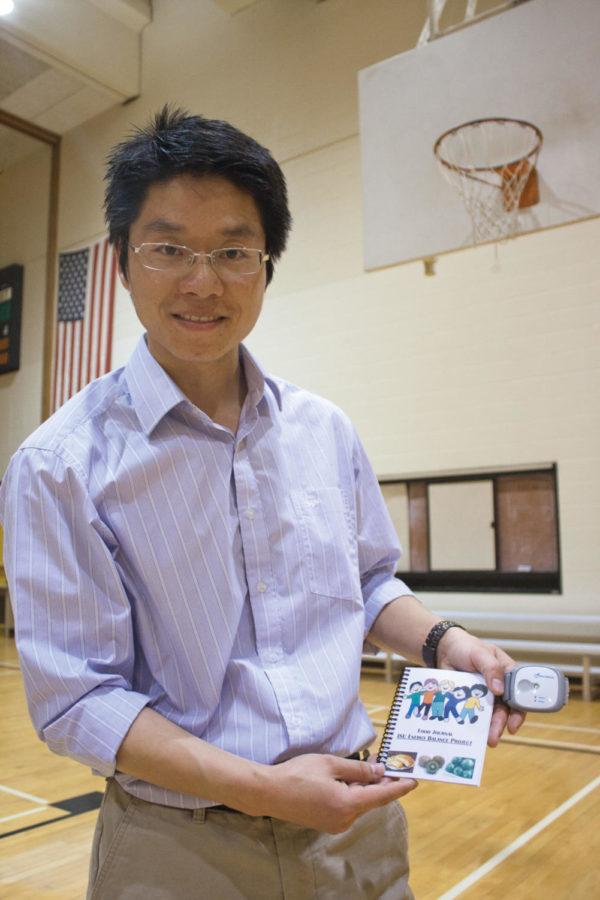Chen hopes research will fight obesity in adolescents
Photo: Andrew Clawson/Iowa State Daily
Senlin Chen, assistant professor of kinesiology, displays the Sense Wear armband and food journal used in his research on middle school students Tuesday, April 24, at Forker Hall. The armband is used to determine how much energy the subject expends.
April 24, 2012
Obesity — it’s a problem that has plagued our society as fast food becomes cheaper than the healthier options in a grocery store, and the easier option always wins in our impatient society.
Last fall, Senlin Chen, assistant professor of kinesiology, was introduced to SenseWear technology by his fellow colleague Greg Welk, director of kinesiology, which offers a better way to educate adolescents on caloric expenditure.
“Dr. Chen approached me about his interest in assessing activity in children, so I shared work that I had done with other groups using the Sensewear,” Welk said. “I had validated the tool for use with children previously, but I was interested in how it would work as a motivation tool in children, so it is a good partnership.”
Using the sensor-based technology that measures behaviors as well as caloric expenditure, the monitor is attached to the skin. While attached, the algorithm and mechanism are measuring caloric expenditure based on parameters such as heat flux, skin temperature and acceleration.
“The monitor operates like a pedometer or step counter, but it has considerably better accuracy than its competitors,” Chen said.
For example, other pedometers are found in stores by brands such as Nike and New Balance, among others.
Physical activity and caloric intake among children have been interests of Chen’s research since graduate school. Using a variety of instruments to measure the input and output of calories, he has a goal to not only understand the process of caloric expenditure but to educate children in their nutrition choices.
“I hope my work could help adolescents be aware of their daily physical activity level and nutrition choice by exposing them to the technology,” Chen said. “In my current research project funded by the College of Human Sciences at ISU, my sixth graders at Ames Middle and Boone Middle schools not only wear the armband monitor, but also write a food journal for a short period of time as an interventional experiment.”
Previously, Chen did several descriptive studies to gauge adolescents’ status of motivation, physical activity and competence-based learning in physical education. The SenseWear research project offers a good opportunity for him to expand his research.
“This project is actually my first intervention study geared toward behavioral change and obesity prevention,” Chen said.
Future goals are already on Chen’s mind in order to provide kids with a better understanding of their health and how to prevent obesity.
“My next step is to incorporate the technology into an educational curriculum where adolescents could receive more systematic education about living a calorie-balanced lifestyle,” Chen said.
He also pointed to the fact that recent evidence suggests that one in three preschoolers and two in three adults are overweight or obese. Chen’s work could help the future generation get a hold on obesity.
“His work will provide a way to teach children principles of energy balance with an engaging new technology,” Welk said.
Chen looks forward to teaching kids in schools the importance of being health conscious, but also looks forward to teaching children of his own with his wife.
“We are planning to have children in the next a couple of years,” Chen said.
With no concrete plans on how to necessarily raise a child, Chen mused the idea of how he would like to go about parenting.
“We would devote a lot of time to teaching and interacting with them. Healthy habits of the parents are likely to culturally reproduce healthy habits among kids,” Chen said. “Physical education was, and still is, my favorite subject. I hope my kids will feel the same.”







